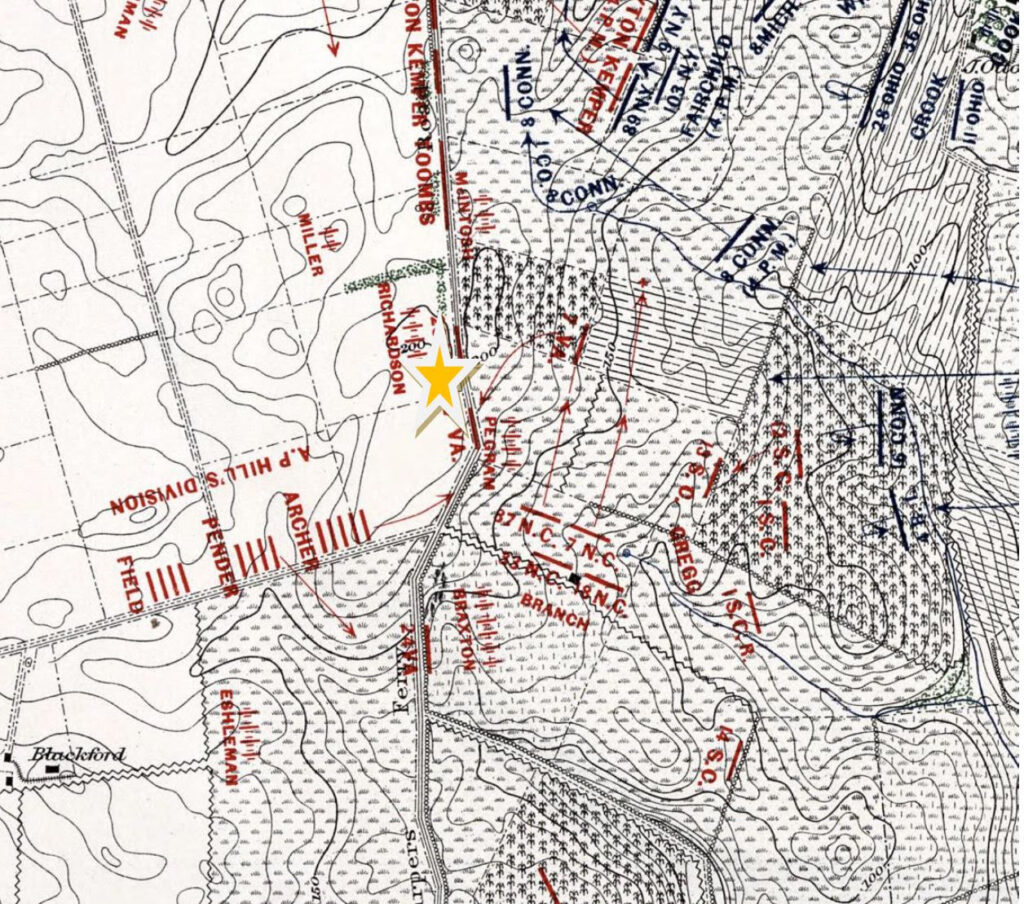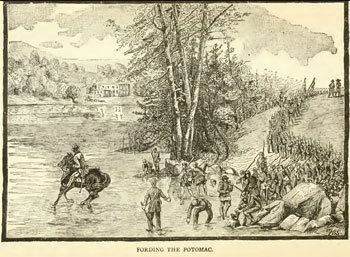(from the April 2008 SHAF Newsletter)
by Scott D. Hann
A West Point classmate once wrote, “He embarked on a career which nothing but death could terminate in failure.” Such confidence in the abilities of Henry Walter Kingsbury were not misplaced.
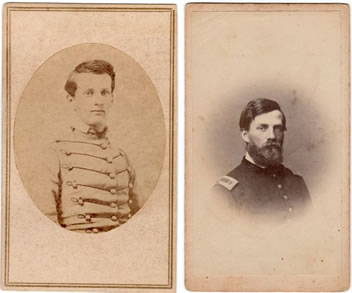
Cadet Henry Kingsbury (left) and 1st Lt. Kingsbury of the 5th US Artillery (courtesy collection of the author)
Henry Kingsbury entered the U.S. Military Academy at West Point in June of 1856. During his five years at the Academy he was frequently promoted and rarely reprimanded. He placed second twice in his five years at the Academy and received only 78 demerits during his entire enrollment at West Point. By his senior year he ascended to the rank of Adjutant of the Corps, graduated fourth overall in the May class of 1861, and placed first in artillery tactics. An impressive achievement considering his class produced 15 Generals and 5 Congressional Medals of Honor.
The coming of the Civil War divided allegiances not only among his West Point classmates but in Kingsbury´s personal life as well. Of the 52 member class of May 1861 forty-one fought for the Union and eleven for the Confederacy. His sister, Mary, wed future Confederate Major General Simon Bolivar Buckner. Their wedding was an auspicious one; during the ceremony the house next door caught fire and the wedding was paused while the groom, clergy and guests doused the flames.
Late in 1861 Kingsbury married Eva Taylor, niece of President Zachary Taylor and sister-in-law of his close friend David R. Jones. Nicknamed “Neighbor” for his gregarious personality, Jones too would advance to the rank of Major General in the Confederate Army. Not noted for his military prowess, (he graduated 41st out of 49 in the illustrious West Point class of 1846, and counted George B. McClellan, “Stonewall” Jackson and A. P. Hill among his classmates), Jones might have owed at least some of his military opportunities to the husband of his wife´s cousin: President Jefferson Davis. While serving as an aide to Brigadier General P. G. T. Beauregard during the bombardment of Fort Sumter it is alleged that Jones personally lowered the Stars and Stripes after that bastion capitulated.
Henry Kingsbury, born in chilly Chicago on Christmas Day in 1836, had a difficult youth. Of his six siblings only his sister Mary lived to reach adulthood. His father, Major Julius Kingsbury, was a career soldier and Henry in every sense an “army brat.” In the 1840s the Connecticut native married Henry’s mother, Jane, who accompanied him to California in 1849 during the Gold Rush. His brief stint at prospecting didn’t bring him any riches but his real estate investments certainly did. While stationed near Lake Michigan during the Black Hawk War Julius invested around $700.00 in real estate on the outskirts of the booming city of Chicago. When the city later enveloped his land he became a very wealthy man virtually overnight. This plot of land would later cause great consternation for the Kingsbury family.
Julius Kingsbury soldiered from Maine to Mexico. Frequent assignments and reassignments, demanding travel and rapid change of clime and climate took their toll on his health. Unable to perform his duties due to his failing health his military career unceremoniously ended when he was dismissed in 1853 “for absence from duty without authority.” Two years later his son-in-law, Simon Bolivar Buckner, resigned from the military in order to help the elder Kingsbury manage his family affairs. Mere days after entering West Point the following year his father died and Henry was granted an unprecedented one week leave of absence. His father’s estate was divided equally among his widow and two children. Buckner and an old army friend, Ambrose E. Burnside, were named guardians for the under aged plebe. With Civil War on the horizon, and their fortunes cemented to real estate in the North, the Buckners thought it wise that Mary’s inheritance be left in the hands of her brother for the duration of the war.
Following his graduation Henry’s services were in high demand. “He is one of the best and smartest men of the class and by far the best soldier” boasted classmate and future artillerist Tully McCrea. Ambrose Burnside, who now commanded a brigade in the Department of Northeast Virginia, wanted him on his staff. But Kingsbury, now commissioned a second lieutenant, was instead assigned as aide-de-camp to Brigadier-General Irwin McDowell commander of the Army of Northeastern Virginia. Following McDowell’s defeat at First Bull Run Kingsbury was assigned to command of Battery D 5th U. S. Artillery and transferred to the Army of the Potomac commanded by his brother-in-law’s former classmate George B. McClellan.
The realities of commanding a battery during active campaigning were not what the West Pointer expected. Teamsters deserted, mules were lost, wagons scuttled to prevent capture, and maps unreliable. At Gaines Mill, during the Peninsular Campaign, a driver took a wrong turn and four caissons were blown up along with a bridge which spanned the line of retreat. Regardless, Brigadier-General George Sykes in his official report credited the battery with saving his right flank and Kingsbury distinguished himself here and again at Malvern Hill days later. At the latter battle “the enemy disappeared” Kingsbury wrote, “blown away by superior fire power.” When he was relieved to replenish his caissons he discovered there was no ammunition for his Parrotts, three of which were unserviceable, then got into a squabble with an unnamed infantry general who insisted that he “fire at a target we could not see.”
After repeated requests from family and friends he finally got his personal affairs in order. While stationed at Fortress Monroe he drew up his will naming Ambrose Burnside and his brother-in-law, John Taylor, as executors. Without having his signature witnessed he signed the document and gave it to John for safekeeping. He also gave into the advice of friends and exchanged his commission in the Regular Army for command of a regiment from his home state: the 11th Connecticut Infantry. By the summer of 1862 he began molding them into his image.
Commanding a large volunteer infantry regiment brought new challenges to Kingsbury, but he adapted quickly. Incompetent officers were replaced by men in the ranks. This move proved so unpopular that his capable officers threatened to resign. While encamped at Fortress Monroe the men had the opportunity to bathe daily and dredge for oysters with their bare feet. But after one officer died of typhoid, and an increasing number of men fell ill, the practice was banned. Kingsbury personally selected the best available campsites, supervised the preparation of food such as rice, and adequately supplied his men with blankets and other essentials. Steak, usually reserved for consumption by officers only, was fed to the enlisted men as well. In time the 11th Connecticut earned the distinction as the “cleanest most orderly and best trained outfit in the division.”
Kingsbury’s transfer to the Army of the Potomac would once again unite him with his old friend Ambrose Burnside, and a fateful meeting with his brother-in-law Confederate Brigadier General David R. Jones. Deposed Major General George B. McClellan was once again at the helm chasing General Robert E. Lee’s Confederate Army as it invaded Maryland. Jones, with his six brigade division, entered Maryland on September 6, encamped at Frederick, and then marched west toward South Mountain. At the battles of Turner’s and Fox’s Gaps fought on September 14, 1862, Jones’ men bolstered the threatened Confederate line. Fox’s Gap was the 11th Connecticut’s maiden battle under the command of Kingsbury, but was withheld from combat due to poor visibility. Three days later at the Battle of Antietam Henry Kingsbury and the 11th Connecticut would get the chance to prove their mettle.
After his defeat at the Battle of South Mountain Lee drew further west and consolidated his forces. He arrayed his army near the small town of Sharpsburg with Jones positioned along the west bank of meandering Antietam Creek defending his right flank. On the opposite side of the creek was the Union 9th Corps led by Ambrose Burnside and Jones’ brother-in-law Henry Kingsbury.
The Battle of Antietam was fought piecemeal in three disconnected phases; the morning phase along Lee’s left flank, the midday phase at his center, and the finale on his right. Rather than attempt a massive fording of Antietam Creek by the 9th Corps it was ordered that a narrow twelve foot wide bridge would be the conduit through which McClellan’s army would attack Jones’ Division. Nineteenth century military science mandated that the proper technique for such an assault was a three-pronged attack. The first unit would create a diversion by a direct assault on the bridge. The second unit would look for an undefended ford to cross through which they would gain the enemy’s rear and attack it from that direction. And the third unit would speedily capture any high ground behind the bridge. Crook’s Ohio Brigade was assigned the most dangerous of these assignments: a direct assault on the well-defended bridge. The 11th Connecticut, acting as skirmishers, would precede the assault and provide covering fire.
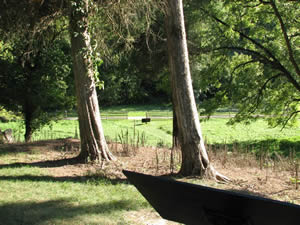
Slope descended by 11th CT at Antietam (photo by the author)
The 11th Connecticut’s assignment was equally perilous. After descending a steep slope they needed to race 50 feet through an open field and find whatever shelter they could along the eastern bank of the Antietam from which to support Crook’s assault. Kingsbury, in particular, would make a conspicuous target. As the 11th Connecticut rushed down the slope and raced for cover they were shot to pieces by Confederates well-concealed on the bluffs on the opposite bank. Kingsbury never reached whatever security the bank could provide. Upon reaching level ground a Confederate bullet broke his leg. Another tore into his foot. As his men raised him up to evacuate him to the rear a third bullet slammed into his shoulder. A fourth and mortal bullet ripped into his abdomen.
Eventually Kingsbury was conveyed to the Rohrbach farmhouse where he joined many of the regiment’s 139 casualties at this improvised hospital. With no hope for his own survival, Kingsbury ordered the surgeons to “take care of the men.” That evening a tearful Major-General Ambrose Burnside visited Kingsbury and in his final hours helped arrange his affairs. Kingsbury’s dying request was that Burnside care for his unborn child. The following evening, September 18, an assistant-surgeon of the 11th Connecticut reported, “the Colonel has opened his eyes and given me the sweetest smile and closed them forever.”
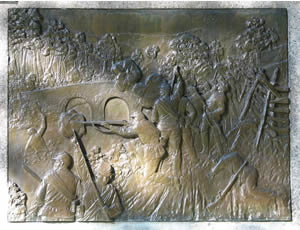
Detail of 11th CT Monument at Antietam (photo by the author)
No one took the death of Henry Kingsbury harder than his brother-in-law David R. Jones. When word reached him that men from his division shot Kingsbury dead Jones was inconsolable. Even Robert E. Lee was stunned by the change in personality of the once vociferous officer. With his will to fight broken, and health deteriorating, Jones resigned not long after the battle. On January 15, 1863, less than four full months after the death of his brother-in-law, Jones died of a massive heart attack or stroke. But those who knew him best know he died of a broken heart.
A month before Jones died Henry’s widow gave birth to their son who was named in his father’s honor. Months after the war ended Henry’s attractive widow remarried and fell victim to an avaricious lawyer. Learning of the prior arrangement in which Henry would act as trustee of his sister’s sizeable inheritance he convinced her to file suit to have the arrangement declared null and void. Against the pleas of her mother-in-law Jane, and an incensed Ambrose Burnside, she proceeded.
Henry’s sister Mary and her husband, ex-Confederate Major General Simon Buckner, were in a precarious position. Not only was Buckner a virtual outlaw in his home state of Kentucky the couple was also broke. Suit and countersuit followed with Burnside and Henry’s mother testifying against his widow. The case eventually reached the Illinois Supreme Court where it decided in favor of the Buckners.
After the death of her second husband Henry’s widow, Eva, married a Belgian diplomat and appears to have lived out her life in Europe. Their son, Henry Jr., grew up in England far from the home his father died defending. Seeking medical treatment in the U. S., he left his home in Alexandria, Egypt and traveled to Baltimore where he died in 1900. Henry’s sister, Mary, died less than three years after the Court decided in her favor. She had little time to enjoy the half million dollars she was awarded.
Money, not Civil War, tore the Kingsbury family apart. While Eva fought to accumulate it, Henry’s mother Jane apparently had little use for it. When she died in 1892, not only her neighbors but even her closest confidant thought she was nearly destitute. When the executors of her will entered her home to inventory her property and rummage around they were shocked by what they found. Neatly stacked in the bottom of dresser drawers were gold pieces totaling $14,000.00. Stashed away in the bottoms of old leather trunks, bureau drawers and in the mattresses of beds were cash and securities amounting to more than $100,000.00. A newspaper reporter wrote, “not a soul in the whole township even suspected it.” In all, her fortune amounted to more than a million dollars which was divided evenly among her two grandchildren.
Every black cloud has a silver lining, and Simon Buckner was one of its most shining examples. In 1862 he surrendered Fort Donelson and its 12,000 men to an old army buddy who was so destitute when he resigned from the military in the 1850s that Buckner paid his way home. During his impoverished latter years again Buckner came to his friend’s rescue, offering financial assistance. And when his friend died of throat cancer in 1885 Simon B. Buckner was one of pall bearers who carried his comrade, “Unconditional Surrender” General Ulysses S. Grant, to his grave.
After the war Buckner served as Kentucky’s 30th governor and ran unsuccessfully for Vice President of the United States. His running mate was John N. Palmer a former Union Major General. Buckner, the last Confederate general above the rank of brigadier general, died in 1914. His son followed in his father’s footsteps or rather in Henry Kingsbury´s. General Simon Bolivar Buckner Jr. was killed at Okinawa in 1945. He was the highest ranking United States officer killed by enemy fire in WWII.
